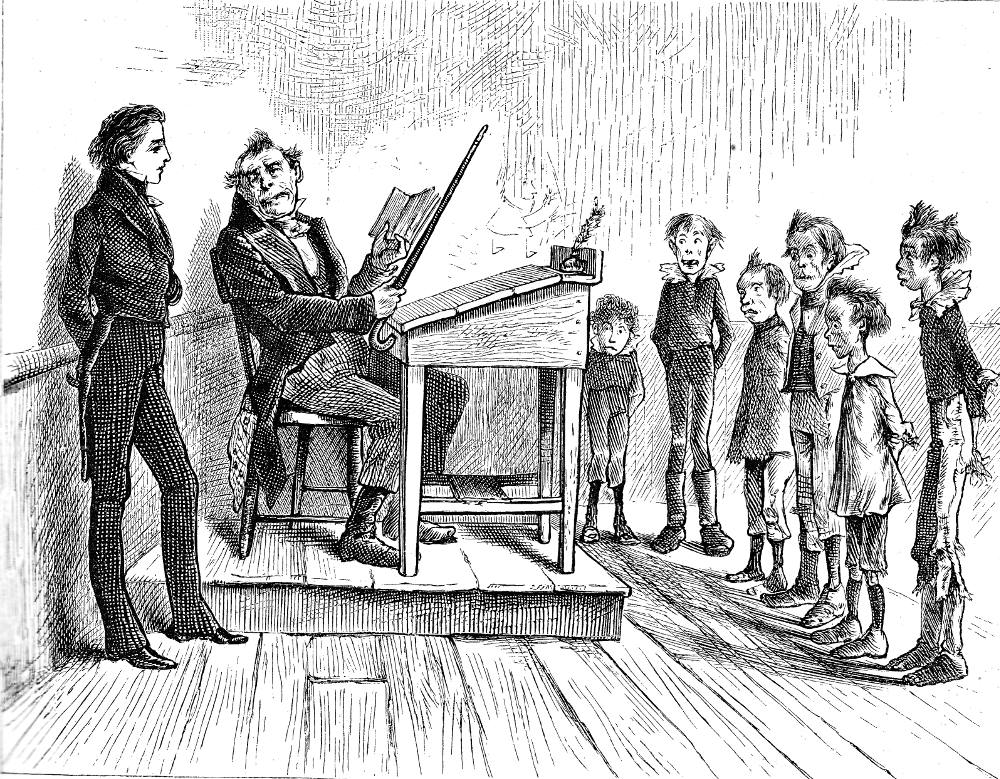
The First Class in English Spelling and Philosophy from the eighth chapter of the novel in the Household Edition, illustrated by Fred Barnard with fifty-nine composite woodblock engravings (1875). 9.3 x 13.5 cm (3 ⅝ by 5 ¼ inches), p. 45, framed. Running head: "Mr. Squeers in Conclave with the Young Noblemen" (47). [Click on the images to enlarge them.]
Passage Illustrated: Nicholas sees Squeers giving an "English and Philosophy" lesson

The Internal Economy of Dotheboys Hall (June 1838), in which Phiz introduces Nicholas and the reader to the illiterate schoolmaster's penny-pinching educational "system."
After some half-hour’s delay, Mr. Squeers reappeared, and the boys took their places and their books, of which latter commodity the average might be about one to eight learners. A few minutes having elapsed, during which Mr. Squeers looked very profound, as if he had a perfect apprehension of what was inside all the books, and could say every word of their contents by heart if he only chose to take the trouble, that gentleman called up the first class.
Obedient to this summons there ranged themselves in front of the schoolmaster’s desk, half-a-dozen scarecrows, out at knees and elbows, one of whom placed a torn and filthy book beneath his learned eye.
"This is the first class in English spelling and philosophy, Nickleby," said Squeers, beckoning Nicholas to stand beside him. "We’ll get up a Latin one, and hand that over to you. Now, then, where’s the first boy?"
"Please, sir, he’s cleaning the back-parlour window," said the temporary head of the philosophical class.
"So he is, to be sure," rejoined Squeers. "We go upon the practical mode of teaching, Nickleby; the regular education system. C-l-e-a-n, clean, verb active, to make bright, to scour. W-i-n, win, d-e-r, der, winder, a casement. When the boy knows this out of book, he goes and does it. It’s just the same principle as the use of the globes. Where’s the second boy?"
"Please, sir, he’s weeding the garden," replied a small voice.
"To be sure," said Squeers, by no means disconcerted. "So he is. B-o-t, bot, t-i-n, tin, bottin, n-e-y, ney, bottinney, noun substantive, a knowledge of plants. When he has learned that bottinney means a knowledge of plants, he goes and knows ‘em. That’s our system, Nickleby: what do you think of it?"
"It’s very useful one, at any rate," answered Nicholas. [Chapter VIII, "Of the Internal Economy of Dotheboys Hall," 46]
Other Artists' Renderrings of the Yorkshire Schoolroom, 1875 and 1910


Left: C. S. Reinhart's American Household Edition illustration of Squeers' classroom management: This is the first class in English spelling and philosophy, Nickleby (1875). Right: Harry Furniss's version of the "Domestic Economy" of the Yorkshire school: Mrs. Squeers dispenses a Delicious Compound (1910).
Related material, including front matter and sketches, by other illustrators
- Nicholas Nickleby (homepage)
- Phiz's 38 monthly illustrations for the novel, April 1838-October 1839.
- Cover for monthly parts
- Charles Dickens by Daniel Maclise, engraved by Finden
- "Hush!" said Nicholas, laying his hand upon his shoulder. (Vol. 1, 1861)
- The Rehearsal (Vol. 2, 1861)
- "My son, sir, little Wackford. What do you think of him, sir?" (Vol. 3, 1861)
- Newman had caught up by the nozzle an old pair of bellows . . . (Vol. 4, 1861).
- Sol Eytinge, Jr.'s 18 Illustrations for the Diamond Edition (1867)
- C. S. Reinhart's 52 Illustrations for the American Household Edition (1875)
- Harry Furniss's 29 illustrations for Nicholas Nickleby in the Charles Dickens Library Edition (1910)
- Kyd's four Player's Cigarette Cards (1910).
Scanned image, colour correction, sizing, caption, and commentary by Philip V. Allingham. [You may use this image without prior permission for any scholarly or educational purpose, as long as you (1) credit the person who scanned the image, and (2) link your document to this URL in a web document or cite the Victorian Web in a print one.]
Bibliography
Barnard, J. "Fred" (illustrator). Charles Dickens's Nicholas Nickleby, with fifty-nine illustrations. The Works of Charles Dickens: The Household Edition. 22 vols. London: Chapman and Hall, 1875. Volume 15. Rpt. 1890.
Bentley, Nicolas, Michael Slater, and Nina Burgis. The Dickens Index. Oxford and New York: Oxford U. P., 1988.
Davis, Paul. Charles Dickens A to Z: The Essential Reference to His Life and Work. New York: Facts On File, 1998.
Dickens, Charles. The Life and Adventures of Nicholas Nickleby. With fifty-two illustrations by C. S. Reinhart. The Household Edition. New York: Harper & Brothers, 1872. I.
__________. Nicholas Nickleby. With 39 illustrations by Hablot K. Browne ("Phiz"). London: Chapman & Hall, 1839.
__________. Nicholas Nickleby. Illustrated by Harry Furniss. The Charles Dickens Library Edition. 18 vols. London: Educational Book, 1910. Vol. 4.
__________. "Nicholas Nickleby." Scenes and Characters from the Works of Charles Dickens, being eight hundred and sixty-six drawings by Fred Barnard et al.. Household Edition. London: Chapman and Hall, 1908.
Created 5 April 2021